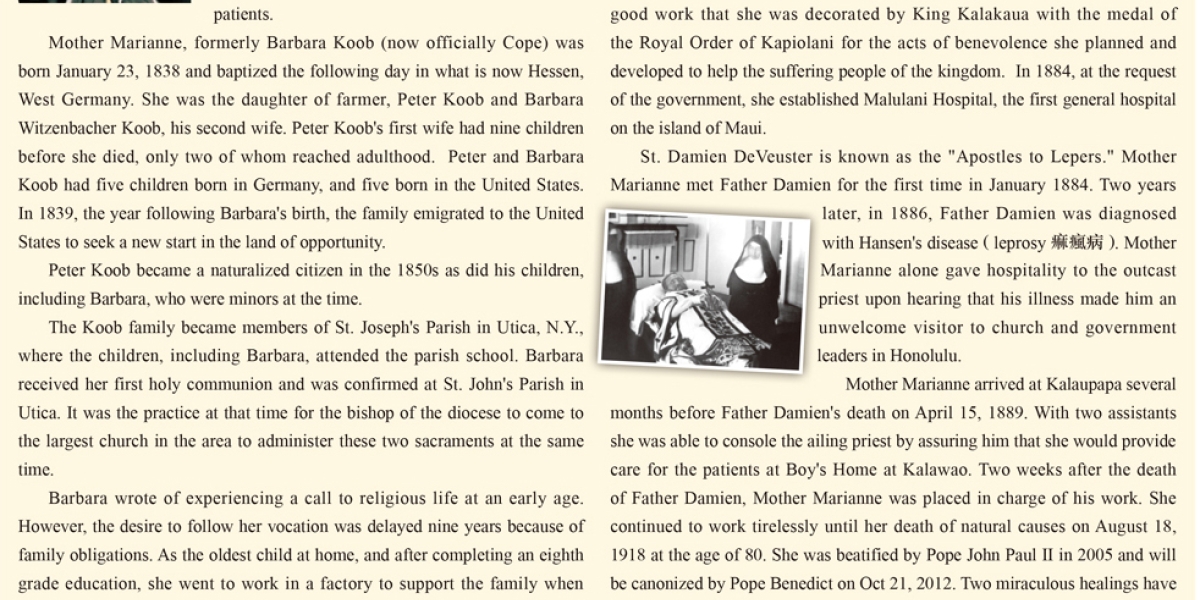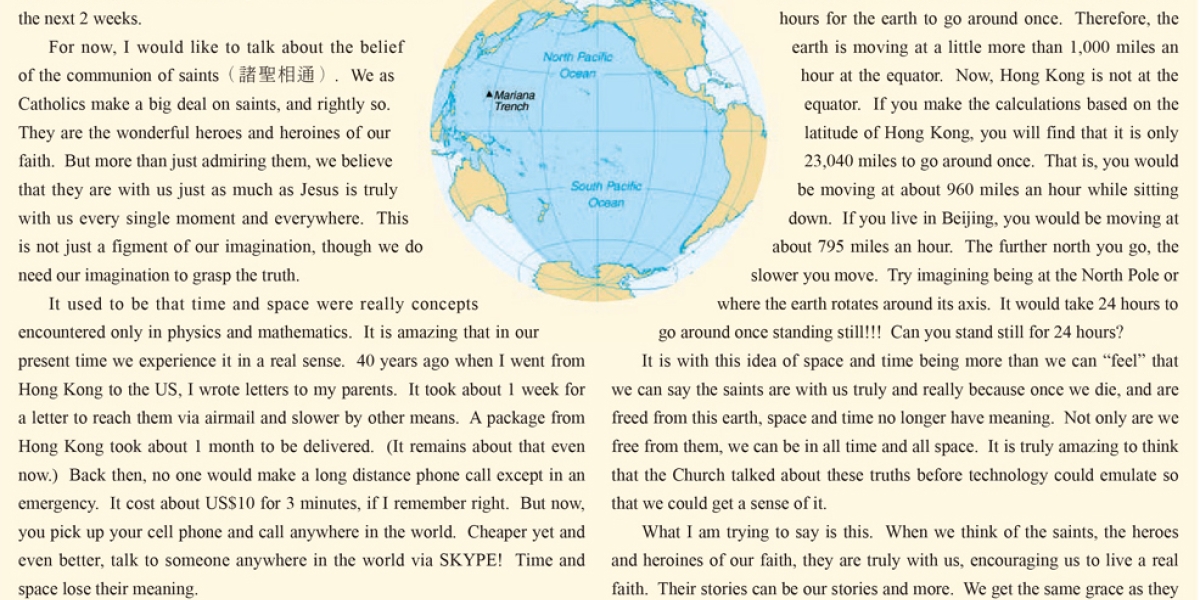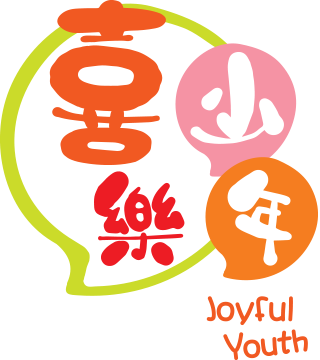昔日文章


Neither East Nor West
2012.10.21
Saint Marianne Cope of Molokai
Mother Marianne led a group of sisters from New York to the Hawaiian Islands in 1883 to establish a system of nursing care for leprosy patients.
Mother Marianne, formerly Barbara Koob (now officially Cope) was born January 23, 1838 and baptized the following day in what is now Hessen, West Germany. She was the daughter of farmer, Peter Koob and Barbara Witzenbacher Koob, his second wife. Peter Koob's first wife had nine children before she died, only two of whom reached adulthood. Peter and Barbara Koob had five children born in Germany, and five born in the United States. In 1839, the year following Barbara's birth, the family emigrated to the United States to seek a new start in the land of opportunity.
Peter Koob became a naturalized citizen in the 1850s as did his children, including Barbara, who were minors at the time.
The Koob family became members of St. Joseph's Parish in Utica, N.Y., where the children, including Barbara, attended the parish school. Barbara received her first holy communion and was confirmed at St. John's Parish in Utica. It was the practice at that time for the bishop of the diocese to come to the largest church in the area to administer these two sacraments at the same time.
Barbara wrote of experiencing a call to religious life at an early age. However, the desire to follow her vocation was delayed nine years because of family obligations. As the oldest child at home, and after completing an eighth grade education, she went to work in a factory to support the family when her father became an invalid. Only when her younger siblings could care for themselves did Barbara feel free to enter the convent. She did so one month after her father's death in the summer of 1862. She was 24 years of age.
Barbara entered the Sisters of Saint Francis in Syracuse, N.Y. on November 19, 1862.
On November 8, 1883, Mother Marianne left with 6 sisters to work in Hawaii. In her first two years on the island, Mother Marianne did so much good work that she was decorated by King Kalakaua with the medal of the Royal Order of Kapiolani for the acts of benevolence she planned and developed to help the suffering people of the kingdom. In 1884, at the request of the government, she established Malulani Hospital, the first general hospital on the island of Maui.
St. Damien DeVeuster is known as the "Apostles to Lepers." Mother Marianne met Father Damien for the first time in January 1884. Two years later, in 1886, Father Damien was diagnosed with Hansen's disease ( leprosy 痲瘋病). Mother Marianne alone gave hospitality to the outcast priest upon hearing that his illness made him an unwelcome visitor to church and government leaders in Honolulu.
Mother Marianne arrived at Kalaupapa several months before Father Damien's death on April 15, 1889. With two assistants she was able to console the ailing priest by assuring him that she would provide care for the patients at Boy's Home at Kalawao. Two weeks after the death of Father Damien, Mother Marianne was placed in charge of his work. She continued to work tirelessly until her death of natural causes on August 18, 1918 at the age of 80. She was beatified by Pope John Paul II in 2005 and will be canonized by Pope Benedict on Oct 21, 2012. Two miraculous healings have been attributed to her.
This is exerted from various sources including
http://blessedmariannecope.org/biography.html
http://www.nps.gov/kala/historyculture/marianne.htm


Neither East Nor West
2012.10.14
Saints Marianne Cope of Molokai & Kateri Tekakwitha, Lily of the Mohawks (莫霍克的百合花)
As mentioned in an earlier article, Pope Benedict will canonize 7 saints on October 21, 2012, two of which will be Sts. Marianne and Kateri. I will write on the two this and next week.
St. Kateri, named after St. Catherine, was born in 1656 to a Catholic Algonquin(阿岡昆族)mother and a Mohawk(莫霍克族)father in the present state of New York. Kateri became an orphan in the year 1660, when the smallpox(天花)epidemic nearly destroyed the entire village, taking the lives of her parents and brother.
Kateri was then adopted by an uncle who had great hatred for the Christian people. The smallpox disease left Kateri with scarred skin and really terrible eyesight. Kateri moved to a new village with her uncle and his family.
After the smallpox epidemic had happened, they burned the old village and moved to Kahnawake (10 miles from Montreal, Quebec, Canada). It was in Kahnawake that Kateri saw for the first time the men they called the Blackrobes. The Blackrobes were the Catholic priests, also known as the Jesuits(耶穌會). Their job was to convert as many natives as they could into becoming Christian. For many years Kateri avoided the Blackrobes but watched with great interest as they did their work. Kateri secretly wished to be baptized a Christian but feared her uncle’s reaction, so she waited until she could no longer bear to be anything but a Christian.
On Easter in 1676, Kateri was baptized. She felt very close to God and spent many hours praying and talking to God. Over the next few years Kateri refused to marry, believing that she was married to God and no man could replace the Lord in her eyes and heart. Many people ridiculed her and her religious beliefs but Kateri would not be scared or threatened into leaving Christianity. She was very devoted to God and the Blackrobes. Kateri escaped from her uncle and the village one day to go north to learn more about Christianity, with the help of her brother-in-law and a Huron Indian.
Once she arrived at her destination, Kateri wanted to become a nun. The Blakrobes said that she was too young to do this, but Kateri proved to them that she was ready, and so they allowed her to become a sister of the mission. Kateri was very happy to spend her life as a servant of God.
As the years went on, Kateri became sick with another illness, tuberculosis (肺癆)had infected her making her weak and very ill. Over time, the disease took away all of Kateri’s strength and finally it took her life.
Kateri died on April 17, 1680 at the mission of Laprairie at the age of twenty-four. Those who were with her when she died said that Kateri’s scars disappeared and she became very beautiful. This was attributed as the first miracle for the cause of her canonization. Her remains are interred at St. Francis Xavier Mission at Kahnawake. (This author has the privilege of offering Mass at the Church several times.)
Since her death many miracles have been claimed due to her intercession. The second miracle officially attributed to her was the 2006 healing of five-year old Jake Finkbonner, when his parents prayed to her as the little boy's face was being eaten away alive from a vicious flesh-eating bacterium. He was cured and remains so today.
She is affectionately known as the Lily of the Mohawks (莫霍克的百合花).
This article is mainly taken from the web sites:
http://www.lily-of-the-mohawks.com/
http://digitaljournal.com/article/316478 - ixzz26k1btKAG


Neither East Nor West
2012.10.05
Communion of Saints and 經緯線
As I mentioned before, Pope Benedict will canonize St. Kateri Tekawitha on Oct 21. Actually, he will also canonize St. Marianne Cope on the same day. I will write about them the next 2 weeks.
For now, I would like to talk about the belief of the communion of saints(諸聖相通). We as Catholics make a big deal on saints, and rightly so. They are the wonderful heroes and heroines of our faith. But more than just admiring them, we believe that they are with us just as much as Jesus is truly with us every single moment and everywhere. This is not just a figment of our imagination, though we do need our imagination to grasp the truth.
It used to be that time and space were really concepts encountered only in physics and mathematics. It is amazing that in our present time we experience it in a real sense. 40 years ago when I went from Hong Kong to the US, I wrote letters to my parents. It took about 1 week for a letter to reach them via airmail and slower by other means. A package from Hong Kong took about 1 month to be delivered. (It remains about that even now.) Back then, no one would make a long distance phone call except in an emergency. It cost about US$10 for 3 minutes, if I remember right. But now, you pick up your cell phone and call anywhere in the world. Cheaper yet and even better, talk to someone anywhere in the world via SKYPE! Time and space lose their meaning.
Let me give you another awesome thought. I do this with my students all the time. I would ask them, while they were sitting at their desks in the classroom, “How fast are you going this moment?” They would say, “Nowhere.” Well, not quite true. You see, the earth is rotating at about 25,000 miles around the equator. It takes 24 hours for the earth to go around once. Therefore, the earth is moving at a little more than 1,000 miles an hour at the equator. Now, Hong Kong is not at the equator. If you make the calculations based on the latitude of Hong Kong, you will find that it is only 23,040 miles to go around once. That is, you would be moving at about 960 miles an hour while sitting down. If you live in Beijing, you would be moving at about 795 miles an hour. The further north you go, the slower you move. Try imagining being at the North Pole or where the earth rotates around its axis. It would take 24 hours to go around once standing still!!! Can you stand still for 24 hours?
It is with this idea of space and time being more than we can “feel” that we can say the saints are with us truly and really because once we die, and are freed from this earth, space and time no longer have meaning. Not only are we free from them, we can be in all time and all space. It is truly amazing to think that the Church talked about these truths before technology could emulate so that we could get a sense of it.
What I am trying to say is this. When we think of the saints, the heroes and heroines of our faith, they are truly with us, encouraging us to live a real faith. Their stories can be our stories and more. We get the same grace as they did. We also get them to be our example. We can learn from them. And we can be with them NOW and FOR ALL ETERNITY.


Neither East Nor West
2012.09.28
Where are we going?
Pope Benedict announced the Year of Faith to celebrate the 50th anniversary of the Second Vatican Council (梵蒂岡第二屆大公會議) and the 20th publication of the Catechism of the Catholic Church(《天主教教理》). He intends for us to take some time to examine our faith in light of both the Council and the Catechism in order for us to look ahead to where we need to go.
For most of you young people, the term “Second Vatican Council” or, even more commonly used, “Vatican II (pronounced as Vatican 2)”, has no particular meaning. Let me give you a little background.
Ever since Jesus instituted the Church 2000 years ago, the Church has encountered challenges due to changing times and cultures. These challenges require the Church to apply what Jesus taught in appropriate reasoning and terminology. The first time the Church took extra-ordinary measures to make a unified decision was recorded in the Acts of the Apostles Ch. 15. It was simply called the Council of Jerusalem. Since that time, there have been 26 ecumenical councils. Only 26. The most familiar to us would be the Council of Nicea in AD 325. Out of that Council, we have the Nicene Creed (《尼西亞信經》)that we recite at each Sunday Mass. Studying the issues of each council is really the study of the growth of the Church in her UNDERSTANDING of the teachings of Jesus. That is, in time, we get to appreciate more deeply than before, the breadth and beauty of certain teachings of Jesus.
Back to Vatican II. After World War I in 1918 and, unimaginably, followed by World War II 20 years later, the world was hurting, really hurting. Almost all countries were suffering from devastation. People questioned whether there was any future for humanity if we could cause such pain to one another. Out of this sadness, Pope John XXIII called for the bishops of the world to gather in Rome to consider how the Church and the message of Jesus could be reignited as a beacon of hope to a hurting world. It was a tremendous endeavor. Out of the meetings, which lasted four years, came 16 documents that are truly uplifting and refreshing. Three particular ones are worth mentioning: “Guadium et Spec”, “Lumen Gentium” and “Dei Verbum”. They are in Latin. When translated, they are entitled “The Church in the Modern World”, “Dogmatic Constitution on the Church” and “Dogmatic Constitution on Divine Revelation.”
It is sad that most Catholics have not read any of the documents. On the other hand, both Blessed Pope John Paul II and Pope Benedict were at the Council and have been trying to bring forth the fruits of the Council for us to grow in our faith.
And the last 50 years have not been easy for the world. You would think that after all the bloodshed of two World Wars, we should be tired of war. The fact is that countries have been waging war on each other continuously with one excuse or another. It is like siblings fighting each other nonstop while mom and dad watch in dismay that their children could hate each other so fiercely. Why can’t they just love each other as we love them?
At the bottom of all this turmoil remains the same problem: the lack of knowledge and understanding of the teachings of Jesus, even for the majority of Catholics and other Christians. It is with this concern that Pope Benedict wants us to take some time to really study our faith. It is not enough that we say we believe. Our faith must have graspable reasons and livable practicality. In the next weeks, we will explore some of our history.


